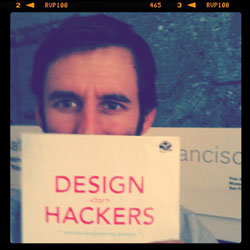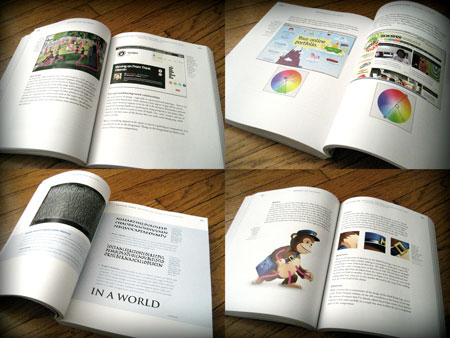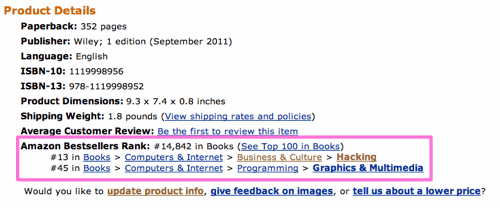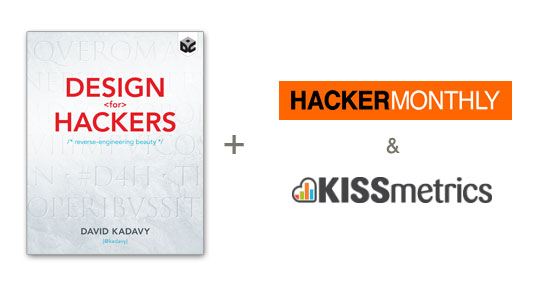Subscribe to blog updates via email »
Design for Hackers (the book) is here!

It was less than 10 months ago that I told you that I would be writing Design for Hackers. Less than 10 months, and the book is already available. In fact, I just signed a bunch of books for some of the amazing 138 backers of the Kickstarter campaign, and I’m also packing my bags and going on tour, starting (oxymoronically) with stops in Boston and NYC next week.
UPDATE (4:33pm CST): I just realized that Design for Hackers is now #36 #22 #18 on ALL OF AMAZON (screenshot below for posterity). Wow, I am so blown away – I never expected this. Thank you. -David

WANT TO WRITE A BOOK?
Download your FREE copy of How to Write a Book »
(for a limited time)

TL;DR
This is going to be a massive post, so here’s a little outline for easy skipping.
- how this book came to be
- the book
- why I want you to buy today
- teaming up with Hacker Monthly & KISSmetrics
- questions?
- I’m going on tour!
Such a fast timeline is typical of “technology” books such as this. There was actually merely 6 months of actual writing time allotted for this book. It was a long, cold, winter holed up in my apartment writing. I put everything on hold: my client work, travel plans (I turned down a free round trip to Hawaii using a friend’s extra airline miles!), and the majority of my social life. There was no time for distractions as I dug in for the biggest project of my life: condensing my entire understanding of what makes good design into 300-or-so short pages.
A lifetime, plus six months
Six months doesn’t seem long, but as I like to tell those who ask, the book took a lifetime, plus six months, to write. It all began with my childhood obsession with drawing. I passed many boring Nebraska days, alone in my room, drawing. I drew everything: I copied from “how-to-draw” books, I drew characters from my favorite video games, and I even drew lettering. My encouraging relatives would sometimes surprise me with $5 bill for drawing when visiting their houses – while my brother mowed the lawn.
When it came time to go to college, it naturally took only moments to choose what I wanted to study: I knew I wanted to do something artistic, and – coming from the fiscally conservative land of Warren Buffett – I also wanted to get a job. “Graphic design” was the clear choice. Honestly, I wasn’t precisely sure what I was getting myself into.
But it was a great fit. I found communicating visually to be challenging and stimulating – purposeful, yet nuanced and artistic. And typography. God, how I grew to love typography. It was rational in being bound to language, yet artistic and expressive.
This love was bolstered by an opportunity to study design in the ruins of Ancient Rome. “Why would you study design in Rome?” people would ask. I wasn’t sure at the time, but I soon learned how important Roman typography was to the history of design. The influence of the letterforms that were born during this time – as products of pen and ink, of chisel and stone – can still be seen in the latest typefaces. Furthermore, understanding this was a perfect conduit through which to understand the most important principle of design: that form is a product of a mixture of intention, culture, and technology. Pandora’s box had been opened, and I was seeing the world through new eyes.
I spent my final semester of college once again locked in my room. Aside from my usual classwork, I devoured every typography book that I could find in my Unversity’s vast library. I read Chappell, Tschichold, more Tschichold, and of course Bringhurst. I conducted experiments in typography, color, and geometry, repeatedly rearranging the words from a bottle of deodorant. I gained new sensitivity not only for letters, but even more so for the tiny bits of space that surrounded them. Seeing typography in a new way, I was forced to rebuild my entire portfolio.
A convergence
This obsession slowly converged with my love for computers and the internet. I drooled at my neighbors’ computer as a child, but it wasn’t until my brother left his college computer at home for a summer that I really got to spend quality time with a computer. I “broke” it countless times, having to reinstall everything. I used the web space that came with my AOL account to make my first website in 1996. It didn’t get updated much, but I got to dabble with HTML.
Then came writing. I never liked writing growing up. In fact, I hated it. I remember reading somewhere that Steven King had said that he was “constantly on fire to write” as a child. That made no sense to me. “That makes no sense to me,” I told my brother.
“You know how you feel about drawing? Well, that’s probably how he felt about writing,” he told me. At that point, it made some sense.
Responding to an irresistible internal force I started my blog in 2004. If you read the first post, it’s clear that I had no idea what I was doing. I think I mostly wanted a playground on which to improve my coding skills. A little more than a year later, I was whisked away to Silicon Valley by a startup.
Discovering the entrepreneur
What I found in California once again rocked my world. It was refreshing to be surrounded by optimism, technological savvy, curiosity for solving problems, and a culture based upon merit. This had not been my environment when growing up in Nebraska.
I was thirsty for the energy of The Valley. Coders got together for all-night software development parties (SHDH), and some startups consisted of a group of 12 guys crammed into a 3-bedroom apartment (Meetro). I rode CalTrain up to San Francisco to go to tech events – only to take the slow midnight train back to San Jose so I could go to work the next day. Suddenly, I was surrounded by people that made sense to me. I was beginning to discover: I was an entrepreneur, and there was nothing I could do to resist that.
Independence Day: starting the journey
Once I was free from employment, I vowed to never work for anyone else again. Working for VC-backed startups had taken it’s toll. I was tired at looking at my paycheck, asking myself “did I really generate that much value in the past week,” and knowing that I had not.
In the summer of 2007, I cashed out some Google and Apple stock that I had bought a few years prior, and began a long road of exploration. I wanted to remind myself that I was really good at something. I felt that if I really trusted my passions, I would eventually be able to create something of value. I wanted to recreate that feeling I had when I was alone in my room, drawing – so engrossed in what I was doing that I would skip meals.
I met up with other entrepreneurial wanderers at cafes in SF, where I now lived. We would explore random projects, helping each other with what we could, for 12 hours a day. I remember many times, leaving a cafe with the realization that I had not made a penny all day – but feeling great about the work I had done.
After a year of this, I had found enough of my entrepreneurial voice that I knew that The Valley wasn’t necessarily for me. I had met amazing people, and had learned a lot about myself, but I knew I didn’t want to raise money for a startup. I knew that the value of paying $1,000 a month for a tiny bedroom (with no job, mind you) had reached the point of diminishing returns. I wanted cheap rent, my own space, and a few cold winters to force me to really dig into my psyche, and hopefully find something good. Chicago was the logical choice.
At this point, I had gotten enough personal projects (and my savings) out of my system that I was ready to do some client work. I set up Kadavy, Inc., and – thanks to the great connections I had made in The Valley – I had some great clients.
Entrepreneurs who make money
Additionally, I was sharing space with entrepreneurs that actually made money. The Valley had taught me to believe in myself, and had unlocked creativity; but finally I was learning the nuts and bolts of business. I learned how to incorporate, invoice clients, and really how to earn my keep.
But I couldn’t stop working on side projects. Eventually, I gained enough passive income (more about that in the future), that I could comfortably pursue my creativity without being too concerned about keeping steady client work. It wasn’t much, but – after a year with no income – I was a master at living small.
This freed me up to explore the love for writing that had developed over the years. There was something exciting to me about packaging concepts into approachable and entertaining bits – like a chef mixing together unlikely ingredients to present bites with an overarching flavor, underlying notes, and a surprising finish.
As always, I wrote about what I knew: a problem I had recently solved, or something so basic that I took it for granted. Eventually it dawned on me that the one obsession that had persisted throughout my life was probably the subject on which I was best equipped to write. One blog post later, I had a book deal.
The book is here today
So, here it is, a lifetime and six months later. Everything that I know about what really makes great design great has been condensed into a few hundred pages. There are few life experiences that haven’t informed this book: from drawing in my room as a child, to studying the graffiti on the walls of Pompeii; from working with architects on typographic installations, to working with back-end developers on Django dash or Rails Rumble; from meticulously experimenting with typography, to producing designs at breakneck pace at a startup; from designing just because I loved to, to designing for economic efficiency – it’s all in here.
This is the product of my journey, and I’m proud to present it to you. Here it is, printed brilliantly in full color.

In it, you’ll find:
- Color Theory: How can you enliven your designs by understanding how colors interact?
- Proportion and Geometry: How can you establish a grid that is suitable for the device on which your design with be displayed?
- Size and Scale: How can you create clean design just by choosing the right type sizes?
- White Space: How can you use it elegantly to communicate clearly?
- Composition and Design Principles: How can you use them to make your designs more compelling?
- Typographic Etiquette: What tiny typographic details can make a huge difference in what you’re communicating?
Spreading design literacy
I see this book as much more than the product of lifelong obsession: I hope that it will be part of a turning point for mankind. It sounds crazy to type that, but really, that’s what I hope for. I hope that it will contribute to the revolution of design literacy.
What do I mean by design literacy? When Gutenberg invented the printing press, very few people knew how to read or write. Just a little over 500 years later, most of us are literate. We learn how to read and write in school. Clear communication is necessary for success.
Now we have tremendous publishing power. We create our own flyers, our own PowerPoint presentations, and we even tweak our Tumblr themes. We’re armed with a dizzying array of fonts – enough to make Claude Garamond blush – and most of us have no knowledge of how they really differ, or how to use them to facilitate clear communication.
I believe it naturally follows that the ability to use design to communicate clearly will eventually be as widespread as the ability to use language to communicate is today.
Starting with the Hackers
So why start with the Hackers? Because they’re the ones who are reinventing the world, one line of code at a time. They break down oppressive business models, and create markets from resources that were previously untapped. They can do this so much more effectively with good design.
Hackers have all of this power because they come from a sharing culture. If they run across an error while programming, a quick Google search or RTFM will likely lead them to a solution. This isn’t true when learning design.
Many designers try to share what they know, but since many of them truly are naturals, they have trouble articulating the decisions that they make. You can’t tell someone to “use white space,” and expect a great result.
In this book, I break down all of the factors that make a design great. I explain how different typefaces convey different moods, and why. I explain how different color arrangements convey different feelings, and how specific colors can communicate specific things in certain contexts. I’ll explain how tiny bits of white space, or tiny typographic details, can change what it is that you’re communcating.
Buy books, get bundles
Today – September 14th, 2011 – is the day I’d like for you to buy this book, so I’ve teamed up with a couple of partners that I know you Hackers will like, plus, I’m offering some of my own time and attention to help you with design. If you aren’t interested in my book, I don’t expect that you’ll buy these bundles just for the extra stuff (though sometimes, the value of what you’ll get is as much as that of the books themselves). Consider these giveaways a “thank you” for buying (from Amazon) today nowish.
What’s in it for me (and other people)
You’ve seen similar promotions from other authors such as Tim Ferriss, Gary Vaynerchuk, or Eric Ries. These great authors do promotions like these because they want as many of you to buy at one time as possible. They’re shooting for the New York Times bestseller list, so they want you not only to preorder lots of copies of their book, but it’s not important to them where you buy the books from. All of the booksellers count towards the New York Time bestseller list for that eek.
But, I’m not expecting to be on the New York Times bestseller list. The genre of my book is far to niche for that: it’s a small but elite group of people who are not only building cool stuff with code, but who also want to build their design skill.
So, I’m shooting for a good Amazon rank. Things have been going well so far. I haven’t really actively asked anyone to buy my book yet, and it’s already an “Amazon bestseller,” ranking as highly as #13 in the “Hacking” sub-sub-category.

If you really look at that rank in context, it looks as if my book is dangerously close to being #1 overall.

As you’ve probably figured out by now, Amazon updates their sales rankings pretty rapidly. So, the more people who buy today, the higher the ranking for Design for Hackers will be.
The higher the ranking for Design for Hackers, the more people who will discover the book while randomly browsing Amazon. The more people who randomly discover the book, the faster design literacy spreads. (I won’t B.S. you either: this helps me out, too: in the form of hopefully paying out my advance, and eventually earning a small royalty per book sale).
What’s in it for you? Hacker Monthly & KISSmetrics
If you’ve enjoyed my writing so far, simply buying my book benefits you. First of all, you get a great book: a full-color, exhaustive breakdown of everything visual. But, the better my book does, the more I can dedicate myself to teaching you about design. Beyond this book, I hope to continue developing content that entertains and informs. I want to teach you how to do my job – as if it were my job.

Hacker Monthly
As an added bonus – as a “thank you” for buying today before Saturday, you’ll get a free 3-month digital subscription to Hacker Monthly (for new subscribers only).
Hacker Monthly condenses the best articles from Hacker News for each month in one easy-to-read issue. I know what it’s like to lose a whole day hitting “refresh” on Hacker News, reading every article that comes through. Hacker Monthly eliminates all of that, and ensures that you see the very best content that comes through Hacker News – all laid out beautifully, on any device you want (PDF, MOBI, EPUB format). Since I really have the Hacker News community to thank for the opportunity to write this book, I’m especially happy to be working with Hacker Monthly as this book launches.
Even if you buy only one copy of the book (which is plenty, really!), you get the Hacker Monthly subscription.
KISSmetrics
For those of you who buy at least three copies of the book, I’ve teamed up with KISSmetrics. In addition to the Hacker Monthly subscription described above, you’ll get a free subscription to KISSmetrics, good for as many as 55,000 “events” per month. KISSmetrics doesn’t even offer a free plan, and normally starts at $29 per month. This plan is lined up just for you guys, and is good for life.
For those unfamiliar, KISSmetrics helps you track and improve the stuff that matters about your customers. Instead of needing to wade through tons of confusing web stats, KISSmetrics keeps you focused on the metrics that will actually help your business grow.
Bootstrapper Bundles
Time remaining for Bootstrapper Bundles: These offers have expired.
For those individual Hackers, or small teams, I’ve wrapped up the above into a few “Bootstrapper Bundles.” These bundles can be redeemed today before Saturday only. Buy extra copies of the book to give to your co-founder, your teammates, or even donate a copy or two to your local library.
- 1 book: get a free 3-month digital subscription to Hacker Monthly. Forward your Amazon receipt to 1book@designforhackers.com
- 3 books: get the Hacker Monthly subscription, and a free KISSmetrics subscription, good for 55,000 actions a month, for life. Forward your Amazon receipt to 3books@designforhackers.com
- 5 books: get the Hacker Monthly & KISSmetrics subscriptions, plus an email consultation of one screenshot. I’ll give you at least 3 tips to improve your design. Forward your Amazon receipt to 5books@designforhackers.com
- 10 books: get the Hacker Monthly & KISSmetrics subscriptions, plus a 2-minute, publicly posted design consultation screencast. This will be just like the ones I did for my Kickstarter backers. Forward your Amazon receipt to 10books@designforhackers.com
If any of this interests you, please buy the book on Amazon »
Design Baller Bundles
Time remaining for Design Baller Bundles: These offers have expired.
Understanding design isn’t just valuable for small companies and teams. I know some of you have entire departments of giant companies – or entire giant companies themselves – that are in need of design literacy. Or, maybe you just like to build forts out of books. Maybe you just hate trees and want to wipe them off of the planet. While you need a ton of books for any of this, I know you also probably need a little time to get budget approval to buy that stack of books. So, I’m giving you guys a whole week to redeem any of these bundles, which also include the Hacker Monthly & KISSmetrics subscription.
- 25 books: HM & KM, plus a 1-hour Skype consultation. We can talk about whatever you want! Forward your Amazon receipt to 25books@designforhackers.com
- 50 books: HM & KM, plus a 1-hour Skype presentation for your company. It will be just like I’m there! Forward your Amazon receipt to 50books@designforhackers.com
- 250 books (damn, playa!): HM & KM, plus I’ll come talk at your company, anywhere in the lower 48. Forward your Amazon receipt to 250books@designforhackers.com
If any of this interests you, please buy the sh*t out of this book on Amazon »
Already bought a book?
Some of you, of course, already bought a book. Or, maybe you’re one of the amazing people who backed my Kickstarter campaign at a level that got you a book. If this is you, or you already bought a book from a retailer other than Amazon, then just forward a screenshot or image of your receipt to the appropriate address above. (if you’re a Kickstarter backer, I’ll just recognize your name – we’re cool)
Does it have to be Amazon? What about Kindle & other ebook formats?
If you’re dead-set on buying from a retailer other than Amazon, or on buying in Kindle or some other electronic format, I still really, really love you; but none of these purchases are eligible for these bundles. Only paperback copies bought from Amazon will count towards the Amazon rank of the book. Thanks a ton for your interest!
Catch me in your city
Thanks to $5,827 raised from 138 amazing Kickstarter backers, I’m going on a U.S. tour. Not to waste any time at all, I’m going to be hitting Boston on the evening of September 19th, and NYC the evening of September 22nd (yes, next week, that’s how fly-by-the-seat-of-my-pants this is). I’m still working out details on venues, but sign up for updates for your city here.



